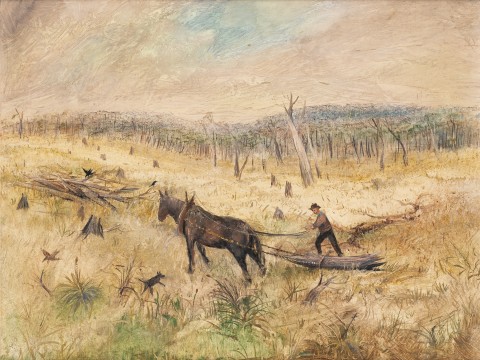MAN CLEARING LAND, HARKAWAY, 1949
ARTHUR BOYD
oil on board
39.5 x 52.5 cm
signed lower right; Arthur Boyd
Private collection, acquired directly from the artist, early 1950s
Macquarie Galleries, Sydney (label attached verso)
Private collection, Perth, acquired from the above, 13 July 1985
Thence by descent
Private collection, Sydney
We are grateful to Rodney James for his assistance with this catalogue entry.
The Harkaway-Berwick paintings were created by Arthur Boyd during a six-month period when he and his young family were living with his uncle, the writer Martin Boyd. Recently returned to Melbourne and buoyed by the financial success of his novel Lucinda Brayford (1946), the elder Boyd established himself in The Grange, the then-dilapidated family home of his grandparents, with the intention of returning it to its former glory. Part of this plan was to involve his relatives with the hope that one of them would share his enthusiasm and, with that in mind, he commissioned his eldest nephew Arthur to paint a cycle of murals for the dining room whilst residing rent-free at the house. Man clearing land, Harkaway, 1949, was painted during these months and is one of a group of works now considered to be ‘a highpoint in the artist’s oeuvre and in mid-century Australian painting.’1
During the war years, Boyd was recognised as one of the rising stars of the Melbourne art world with his agitated scenes of suburban gargoyles and cripples reflecting the turbulence of the times. In 1944, he established the AMB (Arthur Merric Boyd) Pottery with his brother in- law John Perceval whilst also embarking on a sequence of paintings that set biblical stories within a distinctly Australian landscape. Like many of their generation, Boyd and Perceval gleaned much information from Max Doener’s Materials of the artists and their use in painting and experimented with many of the techniques outlined in the book that had been used by old master painters. In particular, Boyd took a number of cues from Rembrandt, Breughel and Tintoretto, adopting their glazes and rich colours for his own work. By the time of his uncle’s commission, Boyd was fully adept with these techniques.
The Grange was sited between Harkaway and Berwick, forty kilometres from Melbourne, a relatively remote location of rolling hills, ploughed paddocks and pockets of remnant bush. It was a gentler setting than the spiked, almost gothic bush that had surrounded his religious subjects, and Boyd sourced most of his images within a two-kilometre radius of his uncle’s house. In Man clearing land, Harkaway, the cleared area is studded with tree stumps as crows and a faithful dog dance about the worker and his horse. A striking touch is the thick application of paint for the sky that surmounts the dense thicket of trees, which in turn contrasts with the foreground where Boyd has laid smoother areas of colour before applying clusters of single strokes to create the sensation of spiky summer grasses. This treatment was likely informed by the artist’s knowledge of his grandmother Emma Minnie Boyd’s own paintings, such as The quail shooter, 1894 (National Gallery of Australia), which bears compositional similarities.2 Although he did not fulfil his uncle’s dream of becoming heir to The Grange, Martin Boyd still financed Arthur’s first solo exhibition at Kozminsky’s Gallery in Melbourne in late 1949, and it is likely that this painting was included. On viewing the show, artist-critic Arnold Shore proclaimed that Boyd ‘assures a hope that we have already broached a new era in Australian art.’3
1. James, R., Home of the Boyds: Harkaway and The Grange, exhibition catalogue, National
Library of Australia, Canberra, 2018, p. 36
2. Ibid., p.19
3. Shore, A., ‘Breughel, guide to local artist’, Argus, 8 December 1949, p.12
ANDREW GAYNOR
